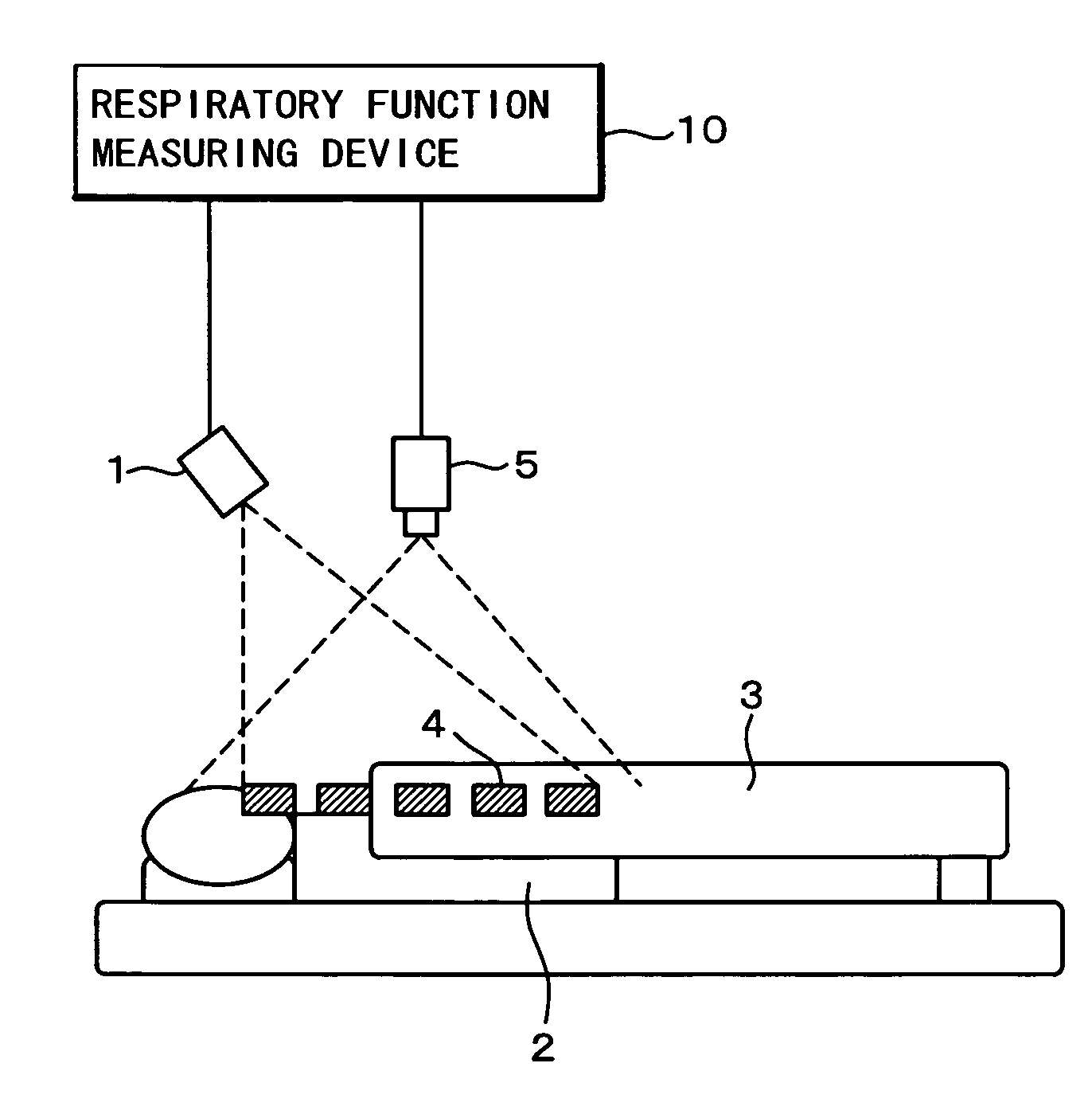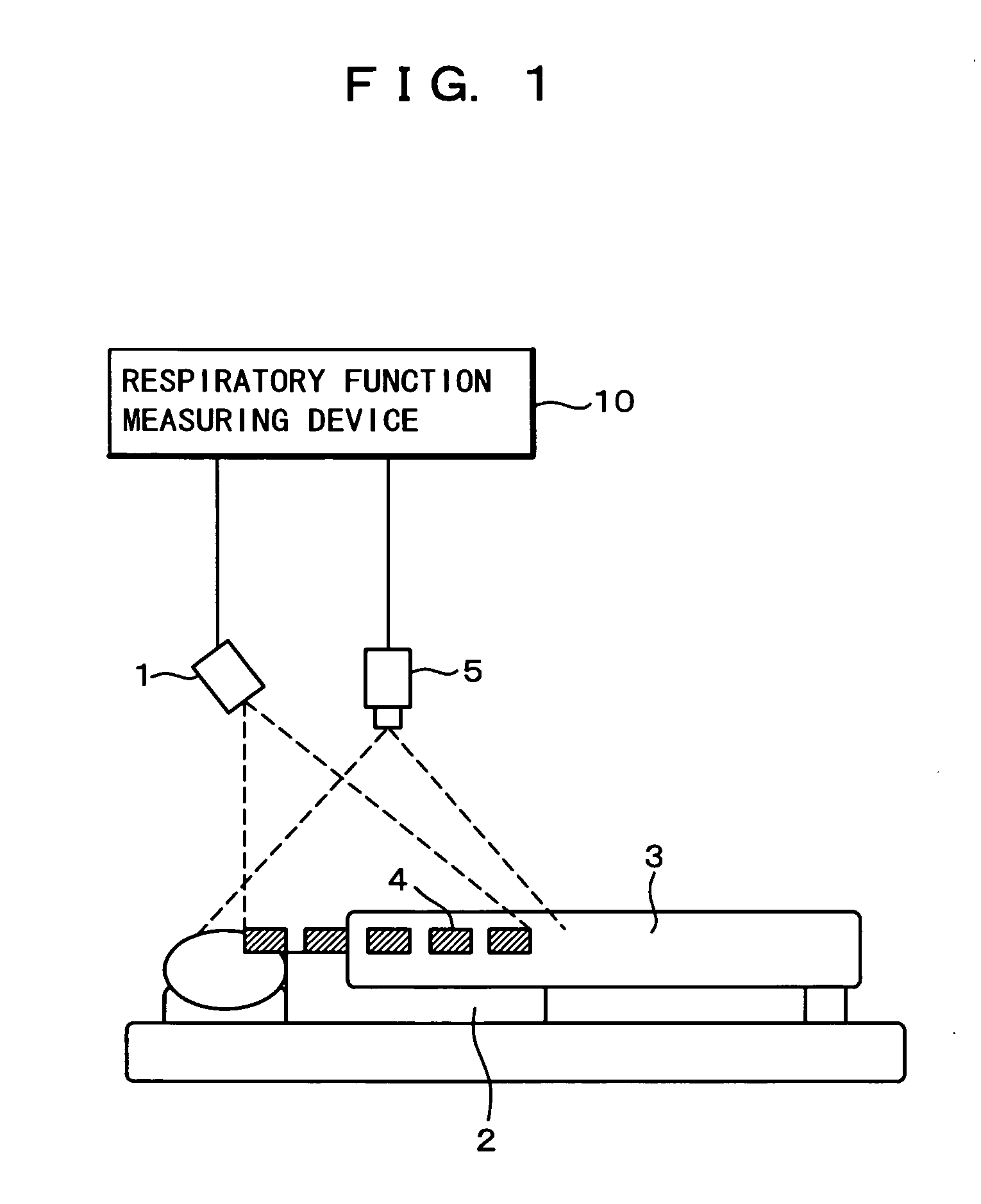Respiratory function measuring equipment and storage medium
a technology for respiratory organs and measuring equipment, which is applied in the field of respiratory organ function measuring equipment, can solve problems such as inability to accurately measure the function of respiratory organs
- Summary
- Abstract
- Description
- Claims
- Application Information
AI Technical Summary
Benefits of technology
Problems solved by technology
Method used
Image
Examples
example 1
[0031]FIG. 1 is a view showing an outline of the configuration of a respiratory function measuring device according to Example 1 of the present invention. The respiratory function measuring device 10 includes a body, a lighting pattern projection means 1, and an image pickup means 5. First, a lighting pattern 4 is projected from the lighting pattern projection means 1 onto a body 2 of a sleeper or bedding 3. The wavelength of projecting light is preferably set to that of infrared rays because the sleeper needs not be aware of being monitored. The lighting pattern 4 projected onto the body 2 or the bedding 3 is picked up continuously as an image by the image pickup means 5. The image pickup means 5 can pick up an image of infrared rays, which correspond to the wavelength of the projected light. Due to a movement in the optical axis direction of the image pickup means 5 of the body 2 or the bedding 3 resulting from a movement of the body 2, a shift of the lighting pattern having a dif...
example 2
[0040]FIG. 5A and FIG. 5B are graphs for explaining principles of the invention of Example 2. The graphs are the same as those of Example 1. In Example 2, attention is focused on a ratio of inspiration time and expiration time within a respiratory time. Because each graph shows a respiratory rate waveform, a positive time of the waveform indicates an inspiration time and a negative time indicates an expiration time. On the horizontal axis of an overall waveform, shown is an inspiration time by a thick solid line, and an expiration time by a thick dotted line. It can be understood that a COPD patient has a longer fraction of expiration time as compared with a control. It is therefore considered that an obstructive pulmonary disease can be diagnosed by computing and outputting (an inspiration time / an expiration time.)
[0041]FIG. 6 is a view of a comparison, between a COPD patient and a healthy person, of the inspiration time / expiration time in quiet breathing state. Here, the vertical ...
example 3
[0046]FIG. 8 is a view of a comparison, between a COPD patient and a healthy person, of the respiratory minute volume in quiet breathing state. Here, the vertical axis represents a respiratory minute volume (ml). The respiratory minute volume corresponds to an amount of ventilation per one minute. An average value of 12 COPD patient samples was 7750 ml, while an average value of 10 control samples was 5530 ml, and thus there is a significant difference with a P value, P=0.029. It is therefore considered that an obstructive pulmonary disease can be diagnosed by computing and outputting a respiratory minute volume. The respiratory minute volume can be determined by calculating the amount of one ventilation×the respiratory rate (times / minute). The amount of one ventilation can be determined, as described above, by calibrating the size of a respiratory waveform according to a spirometry measurement.
[0047]FIG. 9 is a view of a comparison, between before and after use of an inhalation, of...
PUM
 Login to View More
Login to View More Abstract
Description
Claims
Application Information
 Login to View More
Login to View More - R&D
- Intellectual Property
- Life Sciences
- Materials
- Tech Scout
- Unparalleled Data Quality
- Higher Quality Content
- 60% Fewer Hallucinations
Browse by: Latest US Patents, China's latest patents, Technical Efficacy Thesaurus, Application Domain, Technology Topic, Popular Technical Reports.
© 2025 PatSnap. All rights reserved.Legal|Privacy policy|Modern Slavery Act Transparency Statement|Sitemap|About US| Contact US: help@patsnap.com



